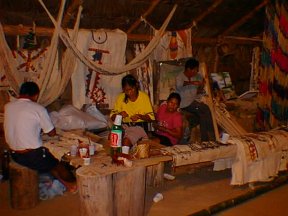
Endangered Languages and their Survival
by Joe Sinclair

(A language is an intricate collectively produced artefact inherited from previous generations.)
In 1995 at a seminar devoted to the cultural issues around the world's minority languages, it was estimated that some 6,500 languages existed. A study made in 2003 revealed that the number of languages actually spoken worldwide had shrunk to around 6,000.[1] At this rate of attrition, languages are dwindling even faster than the world's wildlife. "The threats to birds and mammals are well known but it turns out that languages are far more threatened," [2]
The questions that might be asked are:
1. What is the reason for the loss of ethnic and regional languages?
2. What can be done to halt it?
3. Is there any point in trying to halt it?
But first . . .
SOME
FACTS AND FI
![]() It
has been estimated by demographers and linguists that no more than 3,000
languages will survive the 21st century and two-thirds of these will be under
threat in the following century. [3]
It
has been estimated by demographers and linguists that no more than 3,000
languages will survive the 21st century and two-thirds of these will be under
threat in the following century. [3]
![]() In
New Zealand, during the 20th century, the number of fluent Maori speakers fell
from an estimated 64,000 in the early 1970s, to around 10,000 in 1995.
In
New Zealand, during the 20th century, the number of fluent Maori speakers fell
from an estimated 64,000 in the early 1970s, to around 10,000 in 1995.
![]() Although
English is largely replacing many of the "lost" languages, the English
language is showing a relative decline compared to other languages, This
is attributed to the more rapid population growth in areas where English is not
generally spoken. Other major world languages are, however, declining more
rapidly than English. Italian and French are two such examples.
Although
English is largely replacing many of the "lost" languages, the English
language is showing a relative decline compared to other languages, This
is attributed to the more rapid population growth in areas where English is not
generally spoken. Other major world languages are, however, declining more
rapidly than English. Italian and French are two such examples.
|
"Twenty years ago, everybody spoke French in Spain. Today, in Burgos, there are more French teachers than students!" - Julia Martinez, a teacher from Burgos in Spain |
![]() Mandarin
Chinese is currently - and has been for a considerable time - the world's
largest language in terms of native speakers. The next four major
languages are English, Spanish, Hindi/Urdu, and Arabic. It has been
estimated that by the mid-21st century these four languages will rank equal in
number of speakers, with Arabic rising as English declines.
Mandarin
Chinese is currently - and has been for a considerable time - the world's
largest language in terms of native speakers. The next four major
languages are English, Spanish, Hindi/Urdu, and Arabic. It has been
estimated that by the mid-21st century these four languages will rank equal in
number of speakers, with Arabic rising as English declines.
![]() One
cannot overestimate the impact that the Internet and the worldwide web is having
on language change. English is effectively the lingua franca of the
Internet.
One
cannot overestimate the impact that the Internet and the worldwide web is having
on language change. English is effectively the lingua franca of the
Internet.
![]() A
seminar attended by European language teachers in February 2005 in France
concluded that "French is disappearing from European classrooms in
favour of English. The predominance of English on the internet, the
relative ease of learning basic English and the perception that English is
"cooler" - thanks in large part to popular music and films - means
French is becoming ever more restricted to older generations and the upper
classes of many countries where it used to be the second language of choice in
schools." This was generally deplored. Somewhat
surprisingly, the greatest disapproval was expressed by the Japanese
participants.
A
seminar attended by European language teachers in February 2005 in France
concluded that "French is disappearing from European classrooms in
favour of English. The predominance of English on the internet, the
relative ease of learning basic English and the perception that English is
"cooler" - thanks in large part to popular music and films - means
French is becoming ever more restricted to older generations and the upper
classes of many countries where it used to be the second language of choice in
schools." This was generally deplored. Somewhat
surprisingly, the greatest disapproval was expressed by the Japanese
participants.
![]() From
a commercial aspect, it will be more and more essential for Mandarin Chinese to
be studied, perhaps even replacing French as the second language of choice for
native English speakers, as China bids to become the world's major economic
power.
From
a commercial aspect, it will be more and more essential for Mandarin Chinese to
be studied, perhaps even replacing French as the second language of choice for
native English speakers, as China bids to become the world's major economic
power.
|
"When the Chinese economy has overtaken that of the United States, no one will be able to ignore its global power," - David Graddol, Managing Director of The English Company |
![]() In much of Africa, multilingualism is the norm rather than the
exception and many Africans are able to speak five or six tribal languages in addition
to their own mother tongue. Nevertheless, small tribal languages are under
continual threat from their larger neighbours. The Khoisan language group, for
example, to which the Hottentot and Bushman tongues belong, is almost extinct.
The Cambap language of Cameroon in
West Africa is used by just 30 native
speakers.
In much of Africa, multilingualism is the norm rather than the
exception and many Africans are able to speak five or six tribal languages in addition
to their own mother tongue. Nevertheless, small tribal languages are under
continual threat from their larger neighbours. The Khoisan language group, for
example, to which the Hottentot and Bushman tongues belong, is almost extinct.
The Cambap language of Cameroon in
West Africa is used by just 30 native
speakers.
![]() Asia has many threatened languages including some
located in the Xinjiang and Yunnan provinces of China. . In Southeast Asia,
minority languages in Nepal and Malaysia are under
threat. In Japan, however, Ainu, a threatened tongue spoken in Hokkaido, is making a
comeback as a result of the efforts of native speakers and a change in official
government policy.
Asia has many threatened languages including some
located in the Xinjiang and Yunnan provinces of China. . In Southeast Asia,
minority languages in Nepal and Malaysia are under
threat. In Japan, however, Ainu, a threatened tongue spoken in Hokkaido, is making a
comeback as a result of the efforts of native speakers and a change in official
government policy.
![]() In Australia, one of the areas where language
extinction has exacted the heaviest toll, few of the surviving 250 or so
Aboriginal languages are still viable.
In Australia, one of the areas where language
extinction has exacted the heaviest toll, few of the surviving 250 or so
Aboriginal languages are still viable.
![]() In Arctic North America many Eskimo and Amerindian languages are threatened. The
status of native American tongues in Canada and the United States being worst
hit.
In Arctic North America many Eskimo and Amerindian languages are threatened. The
status of native American tongues in Canada and the United States being worst
hit.
![]() In Central and South America, large numbers of languages are
moribund, while many of the languages that are still viable have drastically
reduced numbers of speakers. The
Leco language of the Bolivian Andes is spoken by about 20 people.
In Central and South America, large numbers of languages are
moribund, while many of the languages that are still viable have drastically
reduced numbers of speakers. The
Leco language of the Bolivian Andes is spoken by about 20 people.
![]() For many years it has been determined and official
policy to re-invigorate the Welsh language. This policy has more recently
been adopted in Cornwall, too, with road signs and place names being shown in
both English and Cornish.
For many years it has been determined and official
policy to re-invigorate the Welsh language. This policy has more recently
been adopted in Cornwall, too, with road signs and place names being shown in
both English and Cornish.
WHAT CAUSES THE LOSS OF ETHNIC AND REGIONAL LANGUAGES?
The decline is due in no small measure to the absence of motivation to retain traditional languages as a consequence of economic and political pressures on minority communities. It does not reflect any deficiency in the languages themselves.
The most obvious sign that a language is about to die is that it is no longer spoken by children. When the older generation dies, the language dies with them. In the severe loss of the Maori-speaking population referred to above, there was virtually no language transmission from Maori parents to their children between the 1960s and the 1970s. Towards the end of the 20th century a determined effort has been made to halt this loss. and in 1987 Maori was made an official language of New Zealand alongside English. Witness the adoption of the "haka" tribal dance by the New Zealand rugby team before its matches.
But the pressure on minor language speakers to stop using their language, and particularly amongst the younger generation, has gradually grown with increased global intercourse; with easier transport communications worldwide; with increased use of computers and the Internet; with greater dissemination of films, books and television programmes. People, and young people in particular, simply don't want to learn languages that they know few people outside their immediate vicinity will be able to understand.
|
"A small community, isolated or bilingual, may continue for centuries to speak a unique language, while in another place a populous language may for social or political reasons die out in little more than a generation." - Foundation for Endangered Languages [4] |
In addition to the general decline of languages as a result of social and economic pressures, there is also an insidious undermining of the strength of minor languages by the introduction into speech of "loan words", that is words taken from another language to replace words that already exist in the minor language. This is a common occurrence in most languages regardless of their size or importance. Witness, for example, the vast vocabulary of French, German, Spanish and Italian words that have been introduced into the English language over the centuries; to say nothing of the Anglo-Indian words that are numerous enough for an entire dictionary to be devoted to them.[5]
An interesting comparison can be made between the decline of languages and the decline of certain species. There is a biological effect known as the Allee Effect (after W.C. Allee who wrote about it in the mid-20th century) whereby the reproduction and survival of individuals decreases as a positive relationship between population density and per capita growth rate. In the animal kingdom this effect may be found when breeding declines because animals have difficulty in finding a mate. Other species such as fish may use more effective strategies such as schooling. The Allee effect may also occur with rare languages. This effect has also been studies by Professor Bill Sutherland [op cit].
WHAT CAN BE DONE TO HALT IT?
We have already referred to the resemblance between the extinction of a language and the extinction of a biological species. Of course, the parallel is not complete. For instance, a world with only one species is an impossibility, whereas it is a theoretical possibility that the world could eventually become monolingual. There is, however, considerable activity worldwide to protect endangered languages.
The European Charter for Regional or Minority Languages was adopted in 1992 by the Council of Europe to protect and promote historical regional and minority languages in Europe.
The charter provides a large number of different actions state parties can take to protect and promote historical regional and minority languages. It applies only to languages traditionally associated with the region and excludes mere local dialects of official languages or languages used by recent immigrants. Languages which have been used historically within regions of a State or by linguistic minorities within the State are, however, incorporated. This includes such languages as Yiddish, Romany, Catalan. Interestingly, the Republic of Ireland is unable to sign the Charter on behalf of the Irish Language as it is defined as the first official language of the state, even though it is a minority language; on the other hand the UK has been able to ratify the Charter in respect of Irish in Northern Ireland where English is the official first language. It has also ratified the Charter in respect to Welsh.
WELSH
The 2001 census reveals that more than 20 per cent of the Welsh population are Welsh speaking, an increase of two per cent in one decade, this despite the fact that 25 per cent of residents were born outside Wales. Although for many Welsh people, particularly in the main Welsh-speaking areas of North and West Wales, Welsh may be their first language of choice, very few indeed are monolingual.
It was during the second half of the 20th century that Welsh began its major revival and this coincided, unsurprisingly, with the rise of nationalist political organisations such as Plaid Cymru. It is very much a living language and the Welsh Language Act of 1993 and the Government of Wales Act 1998 provide that the Welsh and English languages should be treated on a basis of equality. Official literature and public documents are typically produced in both languages and all road signs, as can be seen in the pictures below, are in both English and Welsh.
|
|
|
Aiding the prominence of Welsh has been the creation of the television channel S4C in 1982 which broadcasts exclusively in Welsh during peak viewing hours.
CORNISH
The Cornish language in the south-west of England, like Welsh, is of Celtic origin but shares more of its basic vocabulary with Breton than with Welsh. . Cornish died out in the 19th century and then got revived by enthusiasts in the 20th century. It is estimated that about 300 to 400 people can now speak fluent Cornish and around 3,500 speak it to a basic conversational level.
Cornwall County Council is committed to support the language and passed a motion supporting it being specified within the European Charter for Regional or Minority Languages. There are regular Cornish language periodicals and section in Cornish in local newspapers, as well as a Cornish language radio station.
The language has financial sponsorship from several sources including the Millennium Commission and, as in Wales, bilingual road signs are more and more in evidence.
BRETON
Breton is traditionally spoken in Lower Brittany, France. It was originally the language of the elite until the 12th century. Subsequently the nobility and then the bourgeoisie adopted French. Yet in 1930 1.3 million people were still estimated to speak Breton, although this dropped to a mere 500,000 by the end of the 20th century. One might imagine that the considerable number of Breton speakers would ensure the survival of the language and that it might be protected by the State in the same way as Welsh. However the French authorities have steadfastly refused to grant Breton the status of a national language.
Indeed, Breton is the only Celtic language that is not recognised as an official language because France has refused to change the second article of the Constitution added in 1994 which states that "the language of the Republic is French". The number of protesters demanding the repeal of this article grows year by year, and the publishing of bilingual dictionaries from Breton into other languages, such as English, German and Spanish, demonstrates the determination of a new generation to gain international recognition for Breton..
HEBREW
The most striking example of a language whose decline was not only halted, but expanded, is that of Hebrew in the 20th century. But there were special historical and unique socio-political reasons for this. The revival of Hebrew as a mother tongue is generally attributed to the efforts of Eliezar Ben-Yehuda who had emigrated from Tsarist Russia to Palestine in 1881. He aimed at modernising the ancient literary language and adapting it to everyday communication. It was the second major wave of immigration into Palestine during the early part of the 20th century, however, that gave real impetus and momentum to his efforts. In 1922, under the British mandate, Hebrew was recognised as one of the three official languages of Palestine - the others being English and Arabic. By the time the State of Israel had been formed, Hebrew had become the main language of the Jewish population, replacing Yiddish, Ladino, Arabic, Russian and the myriad other languages brought into Palestine by the people of the Jewish diaspora.
MAORI
For much of the 20th century the Maori language was seemingly heading for extinction in New Zealand with numbers of fluent Maori speakers estimated to have dropped from around 64,000 in 1970 to around 10,000 in 1995. The loss of language actually dated back a generation because there had been little transmission of Maori from parents to children during that time. Subsequently, with the establishment of "language nests"[7] in 1982 the decline was halted.
Language nests provided a fun, home-like environment for children under the age of five, where they were intensively exposed to the Maori language. By the end of the 20th century there were over 800 language nests across the country, and more than 100,000 Maori children had been introduced to their native tongue.
In 1987 Maori joined English as an official language of New Zealand and the original Maori name of Aotearoa (meaning Land of the Long White Cloud) made its appearance on most of the publicity material issued by the New Zealand Tourist Board. Nowadays more than half of all New Zealand's schoolchildren study the language to some extent and many Maori words are finding their way into everyday vocabulary. This is a healthy reversal of the situation that exists when a minority language is in decline.

[Cover of a CD published by Symbiosis Music with music inspired by New Zealand sights and sounds. Details available from the Symbiosis website at http://www.symbiosis-music.com/ ]
One of the most evidential signs of the regeneration of the Maori influence has been the introduction of the haka, a traditional Maori dance intended to intimidate opposition, into the pre-match schedule of the All Blacks New Zealand rugby team.

[A pre-match All Blacks haka]
CANADA'S INDIGENOUS TONGUES [8]
The language nests introduced into New Zealand (see above), whereby pre-school children are taught a heritage language, served as a model for the rescue programme of two First Nations communities in British Columbia, the Province that is home to more than half of Canada's 50 or so indigenous languages. It has been suggested that only three of these languages is expected to survive: Cree, Ojibwa and Inuktitut none of which is historically rooted in British Columbia.
Graduate student Onowa McIvor studied the language nests of Lil'wat and Secwepemc for her master's thesis in the hope of inspiring other First Nations communities to revive their languages.
McIvor examined each of the Lil'wat and Secwepemc community's language
revival stories, the resources they used, how they kept the programme
going and how they overcame barriers. Her passion to protect languages
comes from personal experience; it took just one generation for her
family to lose their aboriginal language.
"My grandparents spoke Swampy Cree but grew up in the era of
assimilation. They were told that maintaining their language would
hinder their children's future," she says. "Consequently, they
were fluent Cree speakers but never spoke it to their children, a story
all too common in Canadian aboriginal history.
McIvor discovered that one of the main barriers to language revival is a
lack of government support. As the Ministry of Health licenses most
childcare programs in B.C., workers must have early childhood educator
certification (ECE). Through ECE certification, childcare programs are
eligible for subsidies and other types of funding, such as capital-cost
start up money. But language nests don't quite fit the mould of other
childcare programs.
"This doesn't mean they are a less-quality program, they're just
different," she says. "Because you need traditional language
speakers to be the main caregivers, those people wouldn't necessarily
have ECE-certified training."
In the Secwepemc community, for example, there are two kinds of people
working in the language nests: elders who are traditional speakers and
"middle-generation" women with education degrees. However,
because they don't have ECE certificates, the program is not eligible
for funding.
"It's quite ridiculous to think about sending either elders or
those with bachelor degrees back for a one-year college course to teach
them how to raise children," McIvor says. "As one community
participant put it, ‘We have been raising our children for thousands
of years. We don't need anyone to tell us how to do it.'"
McIvor believes that, despite funding challenges and even resistance
within their own communities, the Lil'wat and Secwepemc nations offer
inspiration and hope to other indigenous communities in Canada who want
to save their languages.
IS THERE ANY POINT IN TRYING TO HALT IT?
|
"When the last speakers go, they take with them their history and culture." [6] |
In 1994, publisher Rupert Murdoch delivered the 11th annual John Boynthon lecture in Melbourne, in the course of which he said,
"Indian leaders have long been desperately worried about disunity in their vast, teeming, multilingual country. There has been an effort ever since independence to promote Hindi as the lingua franca, what in India is called the "link language". But the effort has failed for a number of reasons.
"Until now. With the coming of the electronic mass media, Hindi is finally spreading because everyone wants to watch the best television programming. And I suspect we will see this story repeated throughout the developing world, not least in China with Mandarin. In which case, it will be not only prosperity that we will catch in our networks, but also order - and ultimately, peace.'
Sounds good. Particularly if you are a media mogul wanting to sell newspapers, TV programmes and other forms of mass communication.
So what is the true value of a language?
Every language contains material that is of value to cultural historians, anthropologists, psychologists and philosophers in addition to the more obvious students of linguistics. The fact is that a language is not merely a means of communicating verbal messages, it is also a storehouse of a people's cultural heritage; it helps to identify their way of life and their sense of identity. Each language contains clues about a people's history.
Before the arrival of Europeans in 1500, Brazil was home to an estimated population of between five and 13 million people in at least 1,000 tribes. Five hundred years of exposure to disease, violence and dispossession wiped out the vast majority of this indigenous population. Today, there are around 350,000 Indians in Brazil in over 200 tribes, who live scattered all across the country. The tribes range in size from the Guarani and Yanomami, who number tens of thousands, to tribes such as the Akuntsu and Kanoê, who number only a few dozen. Between them they speak a vast number of languages, from a variety of language families; 110 of the tribal languages of Brazil have less than 400 speakers.

On April 21st 1995, Bristol University Philosophy Department hosted a one-day seminar, in the course of which reference was made to the Waimiri-Atroari tribe of Brazil.
"Consider the imperilled language Waimiri-Atroari, a language of the Carib family spoken by a precarious community of 500 Indians in Brazilian Amazonia, most of whom are (or were until very recently) monolingual. These people need to share information in order to stay alive, so [the lanuage] has extremely high instrumental value for about 500 people. It has zero instrumental value for everyone else, apart from the traders and officials who wish to communicate with the Waimiri-Atroari.
"The fact that a population needs some medium of communication does not provide a knock-down reason in favour of the particular language, especially in circumstances where [it] is competing against another language. Compared with a world language, the volume of messages actually carried in Waimiri-Atroari is minuscule because the number of speakers is so small. If the same people spoke Portuguese, they would have potential communicational access to 160 million Brazilians. Many of the 500 individuals, and their future children, will in fact learn Portuguese in the next few years. As the proportion of bilinguals in the tribe goes up, so the instrumental advantage of the native language gets eroded. By the year 2000, many of the message-carrying functions of Waimiri-Atroari within the Waimiri-Atroari community may have been usurped by Portuguese. Adult speakers will stop using [it] as their default language. When the children are not even motivated to learn [Waimiri-Atroari], the language will have become moribund."
People define themselves partly in relation to their culture. It is not surprising that the Waimiri-Atroari tribe celebrates its own language and teaches the young people to prize it as a thing of value. A language is an intricate collectively produced artefact inherited from previous generations. Whichever language one absorbs as a child, the truth is that the language is a gift.

[Members of the Waimiri-Atroar tribe at work]
Let us now turn to the impersonal and scientific reasons for preserving an endangered language based on its value as an object of study. Here we must distinguish between existing and living. Let us say that a language's existence is secure, provided there exists an authoritative dictionary of its words, plus a description of its phonetics and phonology, plus a reasonably complete account of its syntax, plus rules for assigning meanings to its sentences. This information defines the language and distinguishes it from all other languages. Additional facts about the language that one would wish to find in an archive include its position in a scheme of classification of the world's languages, its origin, its historical development, the geographical location of its speakers, and so on. Some researches are greatly helped if there exist recordings of speech on tape and video. In the case of a written language, a sample of authentic texts will provide extra information.
Compiling such an archive is usually a feasible task. For each threatened language that still has not been documented, a team of linguists and anthropologists might need to spend ten years collecting data and processing. After that work is done, if the language stops being spoken, there will be a theoretical possibility of reviving it or creating an approximation to it.
Linguists glean a lot from comparing the syntactical rules of different languages. It has been suggested that Noam Chomsky's well- known hypothesis that all human languages conform to an innately specified general pattern, which he called 'Universal Grammar' is supposed to be an empirical hypothesis. Evidence from a wide variety of languages is essential in order to test it properly. For all we know, some language exists which could undermine Chomsky's hypothesis. But if the language were to disappear out without being documented, we would never know that it provided a counterexample.
The fact that a language continues to be alive does yield additional scientific information about processes of change. For a living language is a dynamic entity. Pronunciation and intonation patterns change, new words are coined, even grammatical norms slowly change. Every language has pragmatic rules for performing different kinds of speech acts, manners, gestures, styles of delivery, and so on, which are often highly mutable. Video and sound recordings capture only a small sample of utterances, and these immediately become fossilized.
Archives, however rich, provide only a partial description of that part of a language which has been historically actualized at the time they happen to be compiled. There are scientific advantages in having access to the real thing, and not merely to a record of the thing. But are these advantages important enough to provide an overriding reason to strive to keep a language alive, in cases where it appears to be heading for extinction?
The continuing growth worldwide of government and institutional intervention and legislation suggests that the answer must be a resounding "Yes".
Will such intervention and legislation prove successful in the long run, and against the trend and pressure of media, political, economic and sociological impetus for the unification of language, remains to be seen. it doesn’t take much exposure to a dominant culture, after all, to motivate ambitious young people to replace their mother tongue with a language that gives them better access to education, jobs and new technology.
|
"There's a Welsh proverb I've known for as long as I can remember. 'Cenedl heb iaith, cenedl heb galon'- It means, 'A nation without a language [is] a nation without a heart'" [6] |
![]()
[1] I am here referring to languages spoken by more than 100,000 people.
[2]
Professor
Bill Sutherland, a population biologist at the University of East Anglia, UK
[3]
Atlas of the World's Languages,1994
[4] http://www.ogmios.org/home.htm
[5] Hobson-Jobson: a Glossary of Anglo-Indian Colloquial Words and Phrases, 1886
[6] David Crystal, Editor of The Cambridge Encyclopedia of Language
[7] This was a nationwide network of early childhood centres to nurture a knowledge of the Maori language among children.
[8] Based on article by Lynda Hills, February 2005. The full article and other material relevant to the Canadian indigenous language revival programmes will be found at http://www.turtleisland.org/culture/culture-language.htm